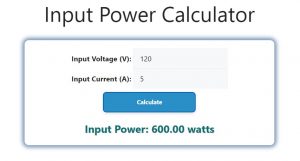About Input Power Calculator (Formula)
Understanding the input power of electrical devices is crucial for both energy management and operational efficiency. The Input Power Calculator allows users to quickly and accurately determine the power consumed by an electrical appliance or system based on its input voltage and current. This information is essential for engineers, electricians, and homeowners alike, helping them make informed decisions regarding energy usage and equipment selection. With a simple formula and easy-to-follow instructions, calculating input power has never been easier.
Formula
The formula for calculating input power is:
Input Power = Input Voltage * Input Current
Where:
- Input Power is measured in watts (W).
- Input Voltage is the voltage supplied to the device, measured in volts (V).
- Input Current is the current flowing through the device, measured in amperes (A).
How to Use
- Gather Required Information: Before using the calculator, ensure you have the input voltage and input current values for the device you wish to analyze.
- Input Voltage: Measure or note the voltage being supplied to the device. This can often be found on the device’s specification label or documentation.
- Input Current: Measure or note the current flowing through the device. This can be done using an ammeter or found in the device specifications.
- Calculate: Enter the input voltage and input current into the Input Power Calculator. The calculator will then compute the input power based on the provided values.
Example
Let’s say you have an electric motor that operates at an input voltage of 120 volts and draws an input current of 5 amperes. Using the formula:
Input Power = Input Voltage * Input Current
Input Power = 120 V * 5 A
Input Power = 600 W
In this example, the input power of the electric motor is 600 watts.

FAQs
- What is input power?
Input power is the total amount of electrical power consumed by a device or system, calculated using its voltage and current. - Why is it important to calculate input power?
Calculating input power helps in assessing energy consumption, designing electrical systems, and ensuring safety and efficiency. - What units are used to measure input power?
Input power is measured in watts (W). - Can I use the calculator for AC and DC devices?
Yes, the calculator can be used for both AC (alternating current) and DC (direct current) devices, though additional factors may be needed for AC calculations, such as power factor. - What is the difference between input power and output power?
Input power refers to the energy supplied to a device, while output power is the useful work performed by that device, often less due to inefficiencies. - How do I measure input voltage?
Input voltage can be measured using a voltmeter, which measures the electrical potential difference between two points in a circuit. - How do I measure input current?
Input current can be measured using an ammeter, which is connected in series with the circuit to measure the flow of electric current. - What factors can affect input power?
Input power can be affected by factors such as voltage fluctuations, device efficiency, and the type of load (resistive, inductive, or capacitive). - What is the formula for calculating output power?
Output power can be calculated using the formula: Output Power = Input Power – Losses (e.g., heat, friction). - Can the input power be negative?
No, input power cannot be negative. A negative reading may indicate a measurement error or reverse current flow in certain contexts. - What is power factor, and why is it important?
Power factor is the ratio of real power used by a device to the apparent power flowing in the circuit. It’s important for evaluating the efficiency of AC systems. - How does temperature affect input power?
Temperature can affect resistance in electrical components, which in turn may affect the current and overall input power consumption. - Is there a difference in calculating input power for different types of devices?
While the basic formula remains the same, additional parameters may be required for devices with complex electrical characteristics, especially AC systems. - What safety precautions should I take when measuring voltage and current?
Always use appropriate safety gear, work with insulated tools, and follow electrical safety guidelines to prevent shocks or accidents. - How can I reduce input power consumption?
Input power consumption can be reduced by using energy-efficient devices, improving power factor, and optimizing operational practices. - What is the relationship between input power and energy costs?
Higher input power generally leads to higher energy costs. Knowing input power helps in estimating monthly or yearly electricity expenses. - Can the input power change during operation?
Yes, the input power may vary depending on the load conditions, operational settings, and environmental factors. - What is the difference between continuous and peak input power?
Continuous input power refers to the power consumed during normal operation, while peak input power is the maximum power consumed during short bursts, such as startup. - Can I calculate input power for renewable energy systems?
Yes, the input power for solar panels, wind turbines, and other renewable energy systems can be calculated using the same formula, adjusting for specific parameters. - Where can I find the specifications for input voltage and current?
Specifications for input voltage and current can usually be found on the device’s label, user manual, or manufacturer’s website.
Conclusion
The Input Power Calculator is an essential tool for anyone looking to understand and manage the power consumption of electrical devices. By utilizing the simple formula and following the outlined steps, users can gain valuable insights into their energy usage, leading to better decision-making regarding efficiency and costs. Whether you’re an engineer, technician, or simply a homeowner, knowing how to calculate input power can greatly enhance your understanding of electrical systems and their operational costs.